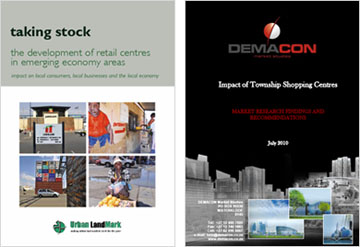The impact of the development of formal retail centres in 'emerging economy' areas in South Africa

01 January 2011
Urban LandMark
English
Information page
Africa
The last decade has seen a significant increase in retail centres being developed in 'emerging economy' areas - townships and rural areas - in South Africa. In Soweto, for example, at least six shopping centres have opened their doors since 2005. Even in the townships of smaller South African cities, shopping centre developments have sprung up, changing the face of commercial transactions for many residing in these areas.
160 retail centres have been developed nationally in the township and rural areas of South Africa between 1962 and 2009, covering about 2 million m² of retail floor space. An estimated R2.4 billion worth of income taxes have been generated by these retail investments since the 1980s. In comparison, an estimated R166 million worth of property taxes have been collected from retail centres over the period - it is projected that Soweto's five retail centres alone contribute about R18 million a year in rates and taxes to the City of Johannesburg. Moreover, these centres have generated about R34 billion worth of business sales, and have added about 54 300 permanent jobs to the national economy since the 1980s.
However, the trend has been met with mixed reactions. Some argue that these centres have a negative impact on the local economies by out-competing local small businesses. Others say retail centres bring a wider range of goods and services closer to the local population at better prices, reducing the need to travel and the associated costs. Still, others think these centres can play an important catalytic role in generating urban agglomerations, initiating urban renewal and the developing of vibrant town centres.
To enable us to understand this market better, Urban LandMark in 2009 appointed Demacon Market Studies to determine the nature and impact of shopping mall developments in South Africa's 'emerging economy' areas and explore ways in which the positive impact of these centres can be maximised and the negative impacts minimised. The initial research findings were complemented by a Training for Township Renewal Initiative (TTRI) case study project and additional expert inputs.
To consolidate this range of research inputs and reflections, Urban LandMark published a shorter booklet, launched on 26 July at a workshop event, "Bolstering Township Transformation". The event was hosted together with the South African Cities Network and the Neighbourhood Development Programme of the National Treasury - partners in the TTRI, together with the Department of Cooperative Governance and Traditional Affairs and the Development Bank of Southern Africa.
The product launch and workshop event further disseminated a set of seven case studies developed by the Neighbourhood Development Programme. The aim of the event was to create awareness of the issues raised in the case studies, by sharing and analysing the relevant research contributions and findings, and to stimulate the uptake of the products with the relevant communities.
Downloads:
- The booklet
- The research report (PDF, 22MB)
- The launch press release (PDF, 161KB) and the launch presentation (PDF, 2.01MB)
- Other case studies launched at the "Bolstering Township Transformation" event
- Retail Centres and Township Development (PDF,3.41MB)
- Developing Township Regeneration Strategies (PDF, 1.59MB)
- Township Regeneration in Small Towns (PDF, 1.72MB)
- Operations & Management of Township Nodal Developments: Khayelitsha Business District Case Study (PDF, 1.7MB)
- Partnerships for Development: Bakubung-Ba-Ratheo and Wesizwe Platinum Case Study (PDF, 1.60MB)
- Creating and Capturing Value Around Transport Nodes (PDF, 1.48MB)
- Partnership Models for Accountability and Monitoring in Municipal Programmes (PDF,1.52MB)
Abstract based on original source.



Comments